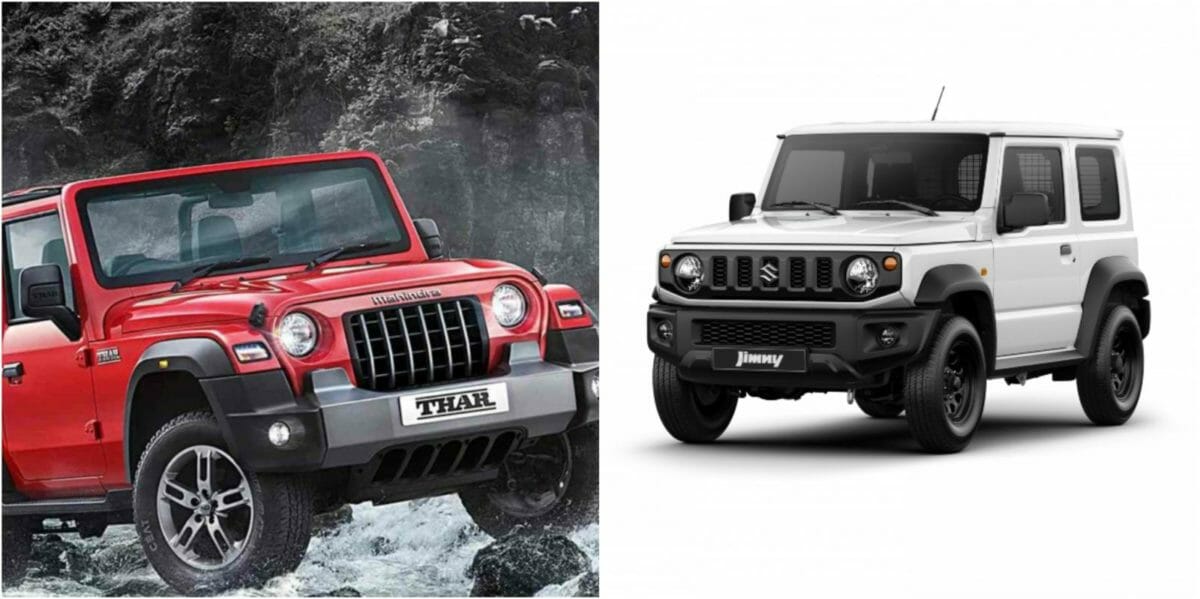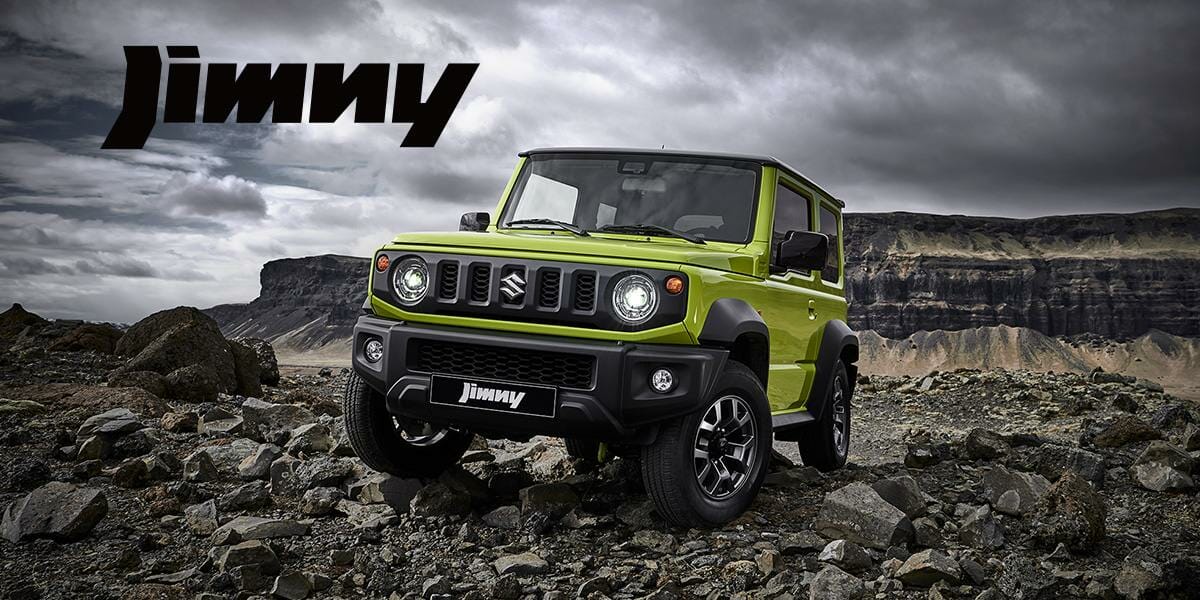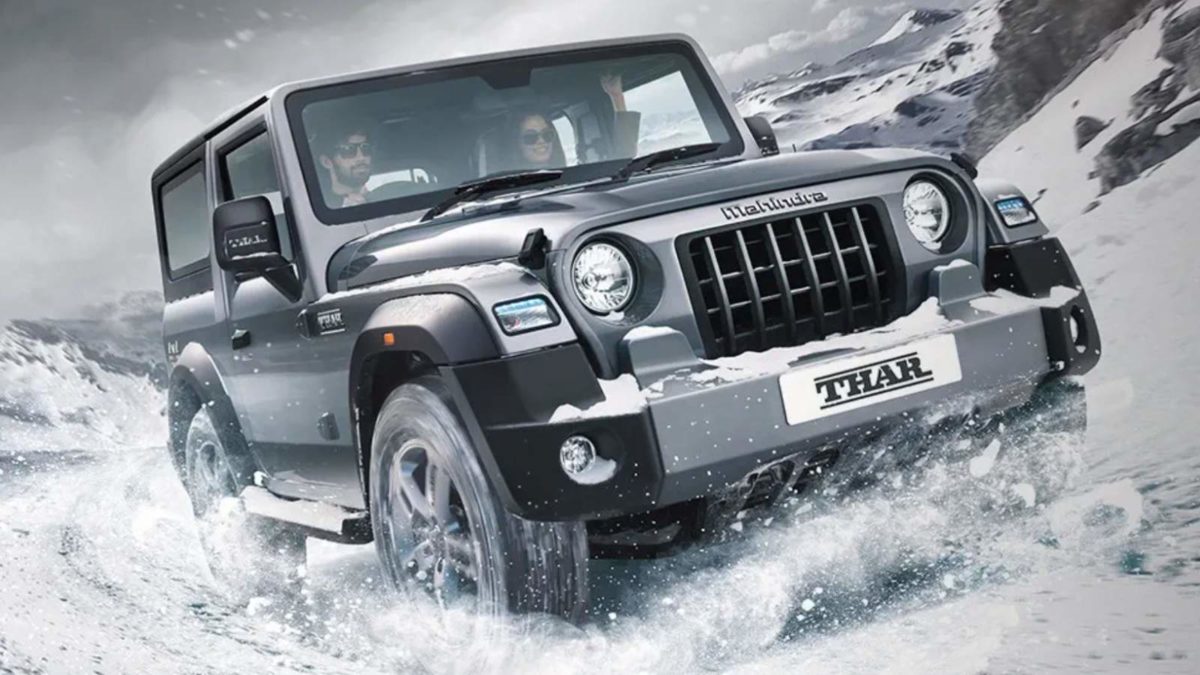The 2020 Mahindra Thar was revealed on Independence Day. Since then, the SUV has achieved more than 15,000 bookings, along with a huge fan base. The new Thar comes as a well-balanced package of modern tech and rugged off-roading characteristics. On the other hand, the Maruti Suzuki Jimny Sierra has been spotted testing, suggesting its arrival in India by early 2021. The Jimny is said to go on sale in India in a 5-door form, however, given the surging popularity of the new Thar, it could also arrive in a three-door form as Maruti’s lifestyle product.
The Jimny will be positioned to cater to the market of the presently discontinued Maruti Suzuki Gypsy. Interestingly, the Maruti Gypsy was actually based on the second-gen of the Jimny. This clearly makes it a rival against the 2020 Mahindra Thar. Here’s a spec comparison to find out which one out of the duo, for now, performs the best on paper.

Mahindra Thar Vs Maruti Suzuki Jimny Design:
An original full-sized SUV is never expected to be aerodynamic. The Mahindra Thar and Maruti Suzuki Jimny, both are equally boxy, beefy, and muscular. While looks are subjective, we can clearly notice that the Mahindra Thar looks similar to the Jeep Wrangler, while the Jimny is often called as a baby Gelandewagen. The way we see it though, there’s nothing wrong with that.
Power and Performance:
The official performance figures for the Maruti Suzuki Jimny are yet to be announced but we expect the engine to be smaller and less powerful compared to the Mahindra Thar. Also, Maruti Suzuki has dropped the diesel engine, which means that the Jimny will only be available with a petrol mill.

The Mahindra Thar comes with a new 2.0-litre ‘mStallion’ petrol engine that gets a 6-speed manual gearbox as standard and also the option of a 6-speed automatic. It’s capable of producing 152bhp of power and 320Nm of torque. Also available as an option is a 2.2-litre mHawk diesel engine, paired with a 6-speed manual gearbox as well a 6-speed torque converter automatic, producing 132bhp of power and 300Nm of torque. A part-time four-wheel-drive system will, of course, come as standard with both, the petrol and the diesel versions, as will a manual-shift transfer case.
| SUV Battle | Engine | Power | Torque | Transmission |
|---|---|---|---|---|
| 2020 Mahindra Thar | 2.0-litre mStallion Turbo-Petrol Engine | 152bhp | 300Nm/320Nm | 6-speed Manual or Automatic |
| Maruti Suzuki Jimny | 1.5-litre K15B Petrol Engine | 101bhp | 130Nm | 5-speed Manual or Automatic |

Off-road handling:
Being an SUV, both Mahindra Thar and Maruti Jimny, come with a partial 4×4 system that can be triggered when required. Both have low-range transfer cases and also come with a shift-on-fly feature that allows you to shift to 4H without stopping. Both the SUVs get a brake locking differential, that cuts off power from free-spinning wheels and directs it to the wheels which require it the most. However, Mahindra Thar leads on the off-roading front, with its mechanically locking rear differential. From the table below, we can see that both the SUVs are capable of going through the tough terrain. With the Maruti Suzuki Jimny having a higher departure angle. However, the Mahindra Thar can swim through twice as deep water. Nothing that a snorkel and some waterproofing of the engine bay cannot fix though.
| SUV Battle | Water Wading Capacity | Departure Angle | Break-Over Angle | Approach Angle |
|---|---|---|---|---|
| 2020 Mahindra Thar | 625mm | 37 Degree | 27 Degree | 42 Degree |
| Maruti Suzuki Jimny | 320mm | 49 Degree | 28 Degree | 37 Degree |
In terms of power to weight ratio, the Maruti Suzuki Jimny weighs 1135 kg for the three-door version. On the other hand, the Mahindra Thar’s weight hasn’t been revealed by the manufacturer, however, it is said to be in the ballpark of 1750 kilos (kerb). If you calculate, both vehicles are almost equally placed in the 87 to 90 bhp/tonne bracket. Given the lighter weight of the Jimny though and with its naturally-aspirated engine, throttle response will be better and it should be able to live up to the “Mountain Goat” tag of its predecessor.

Dimensions:
| SUV Battle | Length | Width | Height | Ground Clearance | Wheelbase |
|---|---|---|---|---|---|
| 2020 Mahindra Thar | 3985mm | 1855mm/1820mm | 1920mm(soft-top) | 219mm/226mm | 2450mm |
| Maruti Suzuki Jimny | 3645mm | 1645mm | 1720mm | 210mm | 2250mm |
According to the table above, the Mahindra Thar is a bigger, wider, and taller SUV, with a longer wheelbase. However, these figures represent the three-door version of the Maruti Suzuki Jimny.
Maruti Suzuki Jimny Vs Mahindra Thar Features:
Both, the Mahindra Thar and the Maruti Suzuki Jimny are targeted towards the urban customers. Both the SUVs come with modern features like LED DRLs, touchscreen infotainment system, Android Auto and Apple CarPlay, Steering-mounted audio controls, Power windows, Cruise control, to name a few. The Maruti Suzuki Jimny comes with a few exclusive features like full-LED headlamps and fog lamps, a rearview camera, camera mounted on the outside rearview mirror opposite the steering, automatic climate control, high beam assist, autonomous braking, and lane departure warning. However, the Mahindra Thar also comes with a lot of features like tyre pressure monitoring system, the optional hardtop, soft top, and a convertible top, a touchscreen that is weather resistant (IP54 rated for dust and water), and a washable cabin with drain plugs in the floor.

On the safety front, both the SUVs get ABS with EBD, dual front airbags, ISOFIX mounts, ESP, Hill hold control, and hill descent control as standard across all variants. However, the Mahindra Thar gets an inbuilt roll cage to increase the stability. On the other hand, the Maruti Suzuki Jimny comes with side and curtain airbags making a total number of six airbags in the top-spec variants.
Final Verdict:
On paper, Mahindra Thar looks to be a more attractive package. This could be the reason behind the carmaker’s achievement of 15,000 bookings. However, Maruti Suzuki Jimny is yet to be launched in India, and the SUV might bring a lot of surprises with it. Overall, for the first time perhaps, we’d have really competent and practical choices in the affordable segment. Choices which can perform well when it’s time to climb a hill on a Sunday or a flyover during peak hours on a weekday.
